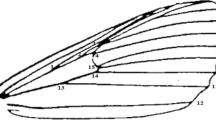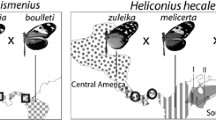Abstract
Accumulating evidence suggests that genotype of host insects influences the development of koinobiont endoparasitoids. Although there are many potential genetic variations that lead to the internal body environmental variations of host insects, association between the host genotype and the parasitoid development has not been examined in a genome-wide manner. In the present study, we used highly inbred whole genome sequenced strains of Drosophila melanogaster to associate single nucleotide polymorphisms (SNPs) of host flies with morphological traits of Asobara japonica, a larval-pupal parasitoid wasp that infected those hosts. We quantified the outline shape of the forewings of A. japonica with two major principal components (PC1 and PC2) calculated from Fourier coefficients obtained from elliptic Fourier analysis. We also quantified wing size and estimated wasp survival. We then examined the association between the PC scores, wing size and 1,798,561 SNPs and the association between the estimated wasp survival and 1,790,544 SNPs. As a result, we obtained 22, 24 and 14 SNPs for PC1, PC2 and wing size and four SNPs for the estimated survival with P values smaller than 10−5. Based on the location of the SNPs, 12, 17, 11 and five protein coding genes were identified as potential candidates for PC1, PC2, wing size and the estimated survival, respectively. Based on the function of the candidate genes, it is suggested that the host genetic variation associated with the cell growth and morphogenesis may influence the wasp’s morphogenetic variation.




Similar content being viewed by others
References
Ayres JS, Schneider DS (2009) The role of anorexia in resistance and tolerance to infections in Drosophila. PLoS Biol 7:e1000150
Beckage NE, Riddiford LM (1982) Effects of methoprene and juvenile hormone on larval ecdysis, emergence, and metamorphosis of the endoparasitic wasp, Apanteles congregatus. J Insect Physiol 28:329–334
Bronstein R et al (2010) Transcriptional regulation by CHIP/LDB complexes. PLoS Genet 6:e1001063
Browning BL, Browning SR (2007) Rapid and accurate haplotype phasing and missing data inference for whole genome association studies using localized haplotype clustering. Genet Epidemiol 31:606–606
Chandra S, Ahmed A, Vaessin H (2003) The Drosophila IgC2 domain protein friend-of-echinoid, a paralogue of echinoid, limits the number of sensory organ precursors in the wing disc and interacts with the Notch signaling pathway. Dev Biol 256:302–316
Debat V, Begin M, Legout H, David JR (2003) Allometric and nonallometric components of Drosophila wing shape respond differently to developmental temperature. Evolution 57:2773–2784
Fry AJ, Palmer MR, Rand DM (2004) Variable fitness effects of Wolbachia infection in Drosophila melanogaster. Heredity 93:379–389
Fytrou A, Schofield PG, Kraaijeveld AR, Hubbard SF (2006) Wolbachia infection suppresses both host defence and parasitoid counter-defence. Proc Biol Sci 273:791–796
Gunasena GH, Vinson SB, Williams HJ (1989) Interrelationships between growth of Heliothis virescens (Lepidoptera: Noctuidae) and that of its parasitoid, Campoletis sonorensis (Hymenoptera: Ichneumonidae). Ann Entomol Soc Am 82:187–191
Han Z, Li X, Wu J, Olson EN (2004) A myocardin-related transcription factor regulates activity of serum response factor in Drosophila. Proc Natl Acad Sci USA 101:12567–12572
Harvery JA, Strand MR (2002) The developmental strategies of endoparasitoid wasps vary with most feeding ecology. Ecology 83:2439–2451
Harvey JA, Harvey IF, Thompson DJ (1995) The effect of host nutrition on growth and development of the parasitoid wasp Venturia canescens. Entomol Exp Appl 75:213–220
Huang W et al (2014) Natural variation in genome architecture among 205 Drosophila melanogaster Genetic Reference Panel lines. Genome Res 24:1193–1208
Ideo S, Watada M, Mitsui H, Kimura MT (2008) Host range of Asobara japonica (Hymenoptera: Braconidae), a larval parasitoid of drosophilid flies. Entomol Sci 11:1–6
Khazaeli AA, Curtsinger JW (2010) Life history variation in an artificially selected population of Drosophila melanogaster: pleiotropy, superflies, and age-specific adaptation. Evolution 64:3409–3416
Kiger JA Jr, Natzle JE, Kimbrell DA, Paddy MR, Kleinhesselink K, Green MM (2007) Tissue remodeling during maturation of the Drosophila wing. Dev Biol 301:178–191
Kuhl FP, Girardina CR (1982) Elliptic Fourier features of a closed contour. Comput GrImage Process 18:236–258
Mackay TF et al (2012) The Drosophila melanogaster Genetic Reference Panel. Nature 482:173–178
Martel V, Darrouzet E, Boivin G (2011) Phenotypic plasticity in the reproductive traits of a parasitoid. J Insect Physiol 57:682–687
Matakatsu H, Tadokoro R, Gamo S, Hayashi S (1999) Repression of the wing vein development in Drosophila by the nuclear matrix protein plexus. Development 126:5207–5216
Mitonaka T, Muramatsu Y, Sugiyama S, Mizuno T, Nishida Y (2007) Essential roles of myosin phosphatase in the maintenance of epithelial cell integrity of Drosophila imaginal disc cells. Dev Biol 309:78–86
Mitsui H, Achterberg KV, Nordlander G, Kimura MT (2007) Geographical distributions and host associations of larval parasitoids of frugivorous Drosophilidae in Japan. J Nat Hist 41:25–28
Paredes JC, Herren JK, Schupfer F, Lemaitre B (2016) The role of lipid competition for endosymbiont-mediated protection against parasitoid wasps in Drosophila. mBio 7:e01006–16
Parrish JZ, Kim MD, Jan LY, Jan YN (2006) Genome-wide analyses identify transcription factors required for proper morphogenesis of Drosophila sensory neuron dendrites. Genes Dev 20:820–835
Pennacchio F, Strand MR (2006) Evolution of developmental strategies in parasitic hymenoptera. Annu Rev Entomol 51:233–258
Ramel MC, Emery CS, Foulger RF, Goberdhan DCI, van den Heuvel M, Wilson C (2007) Drosophila SnoN modulates growth and patterning by antagonizing TGF-β signalling. Mech Dev 124:304–317
Rasband WS (1997–2011) ImageJ. U. S. National Institutes of Health, Bethesda
Roff DA, Mostowy S, Fairbairn DJ (2002) The evolution of trade-offs: testing predictions on response to selection and environmental variation. Evolution 56:84–95
Salazar-Jaramillo L, Paspati A, van de Zande L, Vermeulen CJ, Schwander T, Wertheim B (2014) Evolution of a cellular immune response in Drosophila: a phenotypic and genomic comparative analysis. Genome Biol Evol 6:273–289
Sequeira R, Mackauer M (1992) Nutritional ecology of an insect host-parasitoid association: the pea aphid-Aphidius ervi system. Ecology 73:183–189
Takahashi KH, Okada Y, Teramura K, Tsujino M (2011) Deficiency mapping of the genomic regions associated with effects on developmental stability in Drosophila melanogaster. Evolution 65:3565–3577
Turner MJ, Kleeberger SR, Lightfoot JT (2005) Influence of genetic background on daily running-wheel activity differs with aging. Physiol Genom 22:76–85
Wang HT, Xue M, Chen HN, Zhou FY (2011) Adult oviposition and larvae feeding behavior of Spodoptera litura (Lepidoptera: Noctuidae) on tobacco plants after infested by B-biotype Bemisia tabaci (Homoptera: Aleyrodidae). Ying Yong Sheng Tai Xue Bao 22:1302–1308
Yamamoto A, Zwarts L, Callaerts P, Norga K, Mackay TF, Anholt RR (2008) Neurogenetic networks for startle-induced locomotion in Drosophila melanogaster. Proc Natl Acad Sci USA 105:12393–12398
Yeap HL, Endersby NM, Johnson PH, Richie SA, Hoffmann AA (2013) Body size and wing shape measurements as quality indicators of Aedes aegypti mosquitoes destined for field release. Am J Trop Med Hyg 89:78–92
Acknowledgements
This study was financially supported by International Science and Technology Foundation.
Author information
Authors and Affiliations
Corresponding author
Ethics declarations
Conflict of interest
The authors declare that there is no conflict of interests regarding the publication of this paper.
Electronic supplementary material
Below is the link to the electronic supplementary material.
Supplementary Figure S1
Relationship between phenotypic traits. PC1 and PC2 (a), PC1 and Size (b) and PC2 and Size (c) (PDF 279 KB)
Supplementary Figure S2
Relationship between the numbers of flies emerged in control treatment and wasps emerged in wasp infection treatment (PDF 116 KB)
Supplementary Figure S3
Relationship between morphological traits and estimated survival. PC1 and estimated survival (a), PC2 and estimated survival (b) and Size and estimated survival (c) (PDF 473 KB)
Supplementary Figure S4
Quantile–Quantile plots for PC1 (a), PC2 (b), Size (c) and estimated survival (d) (PDF 266 KB)
Supplementary Figure S5
Linkage disequilibrium (LD) map for the candidate SNPs for PC1 (a), PC2 (b), Size (c) and estimated survival (d) (PDF 907 KB)
Supplementary Figure S6
Effect size and statistical significance of candidate SNPs. Cohen’s d and −log10 (P value) are used as indices of effect size and statistical significance for PC1 (a), PC2 (b), Size (c) and estimated survival (d) (PDF 806 KB)
Rights and permissions
About this article
Cite this article
Yamashita, S., Takigahira, T. & Takahashi, K.H. Genome-wide association analysis of host genotype and plastic wing morphological variation of an endoparasitoid wasp Asobara japonica (Hymenoptera: Braconidae). Genetica 146, 313–321 (2018). https://doi.org/10.1007/s10709-018-0022-2
Received:
Accepted:
Published:
Issue Date:
DOI: https://doi.org/10.1007/s10709-018-0022-2




